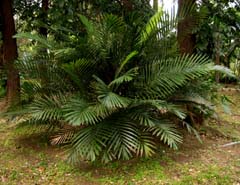Arenga engleri Information
A clump-forming, smallish, water-loving, moderately slow growing, monoecious, forest understorey palm with a hapaxanthic or monocarpic mode of growth where the plant dies after setting seed. Common in cultivation, and common in the wild. It has hairy, black trunks, 4 m. (13 ft.) tall, 12.7 cm. (5 inch) diameter with no obvious leaf scars, and large segmented, pinnate (feather) leaves, 1.2 m. (4 ft.) long, 0.3 m. (1 ft.) wide, dark green above and, greyish green beneath.
This plant is suitable as a houseplant or conservatory plant.
Arenga engleri can survive freezing temperatures to about -6.5°C (20.3°F), but freezing is best avoided. It naturally occurs in wet rainforest or seasonally wet forest in high montane locations. In this type of natural environment temperature fluctuations are slight, and this palm prefers a constantly cool or mild climate with little temperature difference between day & night, and Summer & Winter. Under extreme freezing conditions we recommend you keep this palm as dry as possible, and well wrapped up.
Identification:
Stems clustered, to 4 m tall, 10-15 cm diameter. Leaves pinnate; sheaths fibrous; petioles to 1.8 m long, covered with dark brown, peltate scales; rachis to 3 m long, tomentose as the petiole; pinnae 38-41 per side of rachis, linear, flat adaxially, very briefly lobed along the margins, without ears at the base, regularly arranged and spreading in the same plane except for the basal few pinnae, these paired; middle pinnae 43-49 cm long, 2-2.2 cm wide. Inflorescences interfoliar, unisexual, to 60 cm long, not seen in their entirety; staminate rachillae 9.7-27.6 cm long, 3.6-4 mm diameter, numerous, glabrous; staminate flowers 8-14 mm long, spirally and distantly arranged; sepals 2-2.5 mm long; petals 9-14 mm long; filaments 2-4 mm long; anthers 3-6 mm long; stamens 25-37; pistillate
rachillae 27-32 cm long, 5-7.4 mm diameter, glabrous; pistillate flowers spirally and distantly arranged, 3 mm long; sepals 2.5 mm long, broadly
imbricate, gibbous; petals 3 mm long, valvate for about two thirds their length; fruits globose, 1.5 cm diameter, orange or red. Monoecious, sometimes dioecious. Flowers are separate male & female grouped away on separate stems or plants. Stems die after the last flower has fruited. Germination is slow. Fruits change from green through orange to red/purple.
General Information:
From slopes of dense forests in Taiwan. The species occurs in forest 200 m to 1050 m in the west and 30 m to 1050 in the east, anywhere within Taiwan. I have before collected seeds at the highest elevation that has surely ever been collected, at 1050 m. at this elevation plants become very scarce and quite inaccessible, and finding plants with fruit is almost impossible. These latest Arenga engleri seeds were collected at lower elevation than before and are smaller seeds.
Distribution:
Native to, Taiwan
Location: Taiwan (23.765238°N, 120.992432°E)
Observations
Arenga engleri Overlay Image ©2025 Trebrown - No re-distribution without permission.

